The Huawei Honor 8 Review
by Matt Humrick on October 13, 2016 8:00 AM EST- Posted in
- Huawei
- Smartphones
- Mobile
- Kirin 950
- honor
GPU Performance
Both the HiSilicon Kirin 950, used in Huawei’s Honor 8 and Mate 8, and Kirin 955, used in Huawei’s P9, include an ARM Mali-T880MP4 GPU running at up to 900MHz. The T880 is the highest performing ARM GPU currently shipping, and is based on the Midgard architecture. It supports the latest graphics APIs, including OpenGL ES 3.1 + Android Extension Pack (AEP), and includes 3 ALUs/core, giving it up to 108 GFLOPS of peak theoretical FP32 throughput.
Having only four cores hurts peak performance, however. The Exynos 8890 version of the Galaxy S7 also includes a T880 GPU running at up to 650MHz, but in a 12 core configuration, giving it more than twice the peak FP32 performance of the Honor 8 at 234 GFLOPS. Even last year’s Galaxy S6 family, using the previous generation T760MP8 GPU, is capable of 15% better FP32 throughput.
It's not just ALU performance where the Honor 8 trails flagship phones either. With its limited number of cores, each of which contains a single texture unit, along with supporting hardware for triangle setup, rasterization, tiling, etc., it falls behind in workloads that are not limited by shader performance too.
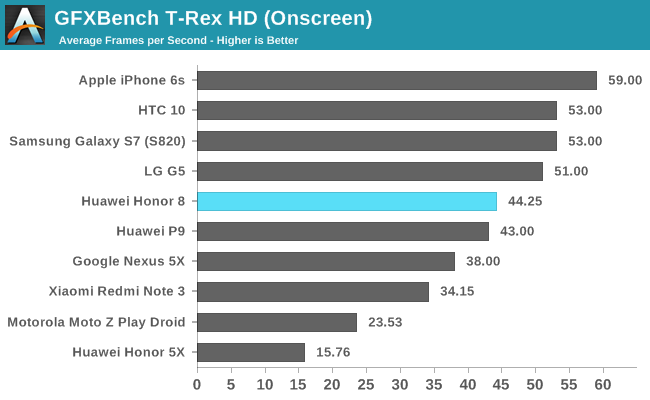
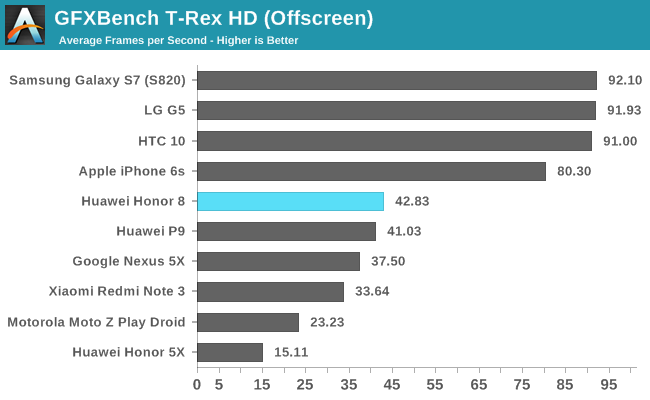
We can already see the effects of this design decision in the older OpenGL ES 2.0-based GFXBench T-Rex game simulation, where the Snapdragon 820 phones outpace the Honor 8 by a factor of two when rendering offscreen at 1080p. Comparing it to other phones at or below its price point shows it holds a 27% advantage over Xiaomi’s Redmi Note 3, which uses a Qualcomm Adreno 510 GPU, and delivers almost twice the performance of the Moto Z Play Droid and its Adreno 506 GPU.
Even when rendering onscreen at a higher 1440p resolution, the three Snapdragon 820 phones still outpace the 1080p Honor 8, although by a much smaller margin.
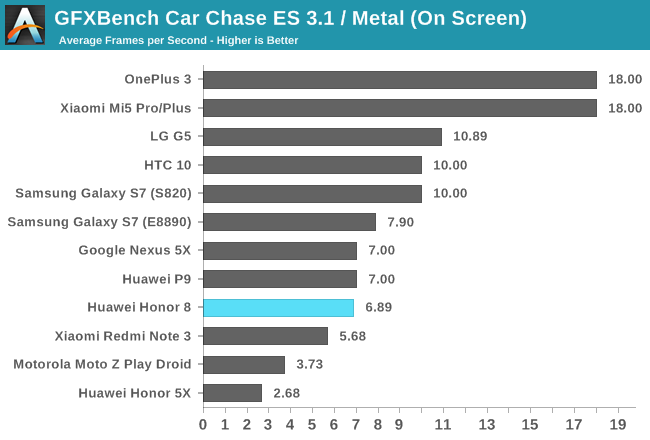
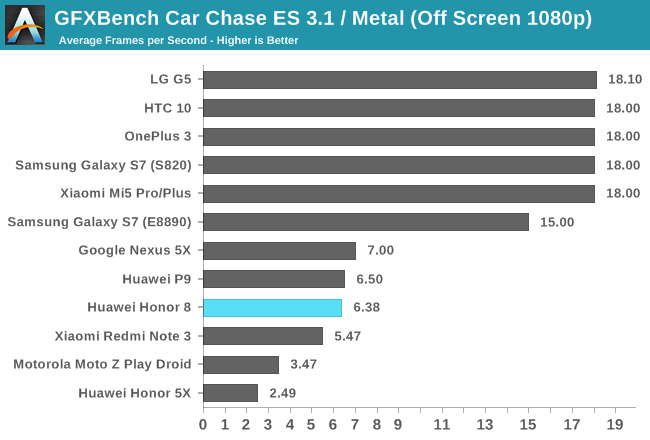
GFXBench Car Chase is a game simulation that uses the latest features, such as hardware tessellation, in OpenGL ES 3.1 plus Android Extension Pack (AEP) and puts a lot of stress on shader performance. The Adreno 530 GPU in the Snapdragon 820 delivers excellent ALU performance, outpacing the Honor 8 by 3x when rendering at the same resolution offscreen. The Exynos 8890’s eight extra cores pay dividends in this workload, allowing it to outperform the Honor 8 by a factor of two, which is similar to the difference in theoretical ALU performance.
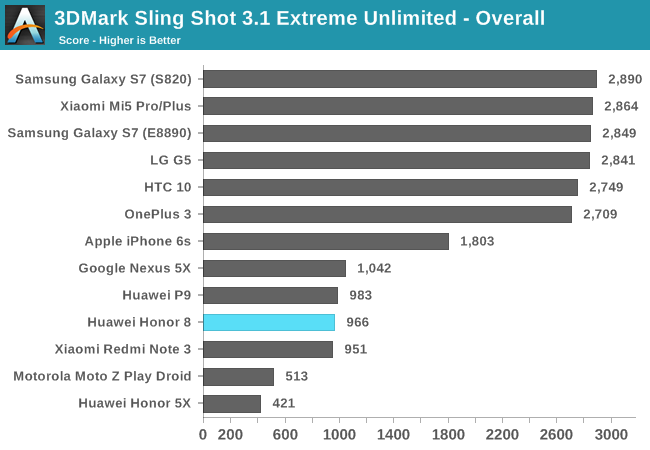


3DMark Sling Shot Extreme uses either OpenGL ES 3.1 on Android or Metal on iOS and stresses the GPU and memory subsystems by rendering offscreen at 1440p (instead of 1080p like our other tests). With more pixels to process, the Honor 8 falls even further behind. The phones with Snapdragon 820 and Exynos 8890 are about 4x faster in the graphics tests. It even falls slightly behind the Xiaomi Redmi Note 3 Pro in the first graphics test that focuses more on processing geometry, but pulls about even in the second test that stresses pixel shading.
The finishing order looks quite different in the Physics test, which focuses on CPU and memory controller performance. The Kirin 950/955 hybrid memory controller appears particularly adept at handling the more random memory access pattern used by this test, something Apple’s SoCs have struggled with for some time.
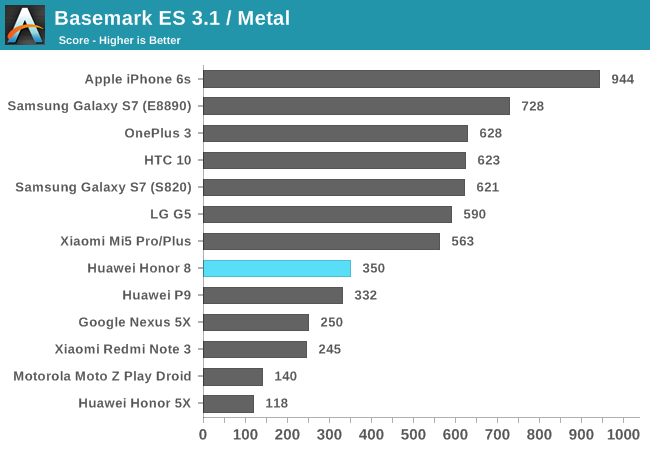
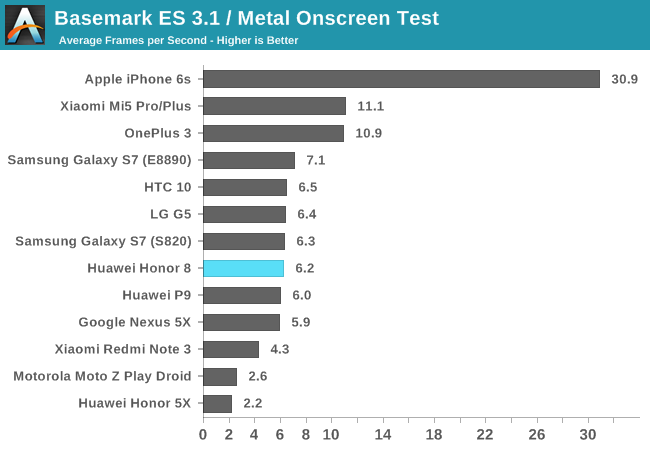
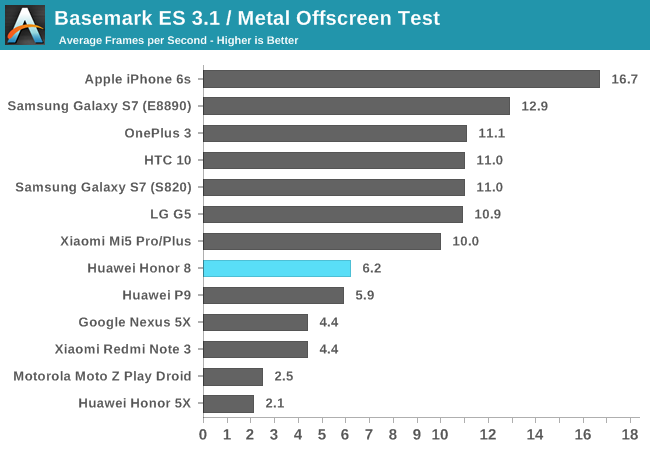
Basemark ES 3.1 also uses either OpenGL ES 3.1 on Android or Metal on iOS. Its rendering pipeline and feature set are similar to GFXBench 4.0 Car Chase, except it does not utilize tessellation. There’s both on onscreen and offscreen test, with the offscreen test rendering at 1080p.
The iPhone 6s performs well, partially because it’s using Apple’s Metal API and partially because it’s only rendering at 750p for the onscreen test. The Xiaomi Mi 5 and OnePlus 3 have 1080p displays, which also gives them an advantage over the 1440p phones in the onscreen test.
Looking at the offscreen results shows that the Galaxy S7 and its Mali-T880 GPU in a 12 core configuration holding a small advantage over the Adreno 530. The Honor 8 and P9 fall significantly behind once again, but they do perform better than the Moto Z Play Droid.
While the Honor 8 cannot match the peak graphics performance of current flagship phones, including the similarly priced OnePlus 3, it does support the current graphics APIs and features. It’s also sufficiently powerful enough to play most games currently available on Android. The Honor 8 is not the ultimate gaming weapon; there will be occasional stutters and it’s possible there are some intense games it cannot play, but it generally provides an adequate gaming experience.










95 Comments
View All Comments
hemedans - Thursday, October 13, 2016 - link
its not efficient compare to 820 check gsmarena for batterylife, compare it with sd820 phone with 1080p display like xiaomi mi5-honor 8 endurance 70h
-xiaomi mi5 endurance 92h
xiaomi did beat honor 8 in all three test call, browsing and video playback
Impulses - Thursday, October 13, 2016 - link
Will be interesting to see where the Pixel falls: 820 + 1080p - slightly smaller battery + better optimizations, you'd hope.Impulses - Thursday, October 13, 2016 - link
821 rather...Meteor2 - Thursday, October 13, 2016 - link
Hmmm? Gsmarena lists specs, not test results. The test results in this review demonstrate that this phone is very efficient.LauRoman - Thursday, October 13, 2016 - link
But the Qualcomm is way more compatible, with play store apps. Sure, for the average joe, the facebook apps work on almost anything, but when you find a game or some other app that won't work ypu're gonna be so mad.Gordonium - Friday, October 14, 2016 - link
Wheres that come from? Kirin use ARM cores and ARM GPU, which makes it just as compatible as samsung exynos. I think most developers will expect their apps to run on a samsung.close - Friday, October 14, 2016 - link
Everybody knows you shouldn't buy Asian phones since they will probably not be compatible with American or European hands and ear/mouth placement. And let's not forget the vast number of applications that simply won't start on a blue phone.LauRoman can only confirm that Anandtech's readerbase just hit a new low.
ianmills - Sunday, October 16, 2016 - link
Are you the ghost of steve jobs?Lolimaster - Friday, October 14, 2016 - link
There are many games that are kind of broken with mali gpu's. You can see a video of gta san andreas on exynos vs snapdragon.negusp - Friday, October 14, 2016 - link
You have no idea what you're talking about. I think you're referring to x86 CPUs (Intel Atom), which aren't compatible with quite a few apps.The Kirin and Qualcomm SoCs are ARM and therefore have pretty much the same compatibility with all apps.